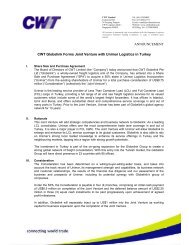notes to the financial statements - Investor Relations
notes to the financial statements - Investor Relations
notes to the financial statements - Investor Relations
You also want an ePaper? Increase the reach of your titles
YUMPU automatically turns print PDFs into web optimized ePapers that Google loves.
NOTES TO THE FINANCIAL STATEMENTS<br />
YEAR ENDED 31 DECEMBER 2011<br />
3 SIGNIFICANT ACCOUNTING POLICIES (CONT’D)<br />
3.5 Intangible assets<br />
Goodwill<br />
Goodwill and negative goodwill arise on <strong>the</strong> acquisition of subsidiaries, associates and jointly-controlled entities.<br />
Goodwill represents <strong>the</strong> excess of:<br />
• <strong>the</strong> fair value of <strong>the</strong> consideration transferred; plus<br />
• <strong>the</strong> recognised amount of any non-controlling interests in <strong>the</strong> acquiree; plus<br />
• if <strong>the</strong> business combination is achieved in stages, <strong>the</strong> fair value of <strong>the</strong> existing equity interest in <strong>the</strong> acquiree,<br />
over <strong>the</strong> net recognised amount (generally fair value) of <strong>the</strong> identifiable assets acquired and liabilities assumed.<br />
When <strong>the</strong> excess is negative, a bargain purchase gain is recognised immediately in profit or loss.<br />
Subsequent measurement<br />
Annual Report 2011<br />
Goodwill is measured at cost less accumulated impairment losses. In respect of equity-accounted investees, <strong>the</strong> carrying<br />
amount of goodwill is included in <strong>the</strong> carrying amount of <strong>the</strong> investment, and an impairment loss on such an investment is<br />
not allocated <strong>to</strong> any asset, including goodwill, that forms part of <strong>the</strong> carrying amount of <strong>the</strong> equity-accounted investee.<br />
O<strong>the</strong>r intangible assets<br />
O<strong>the</strong>r intangible assets are measured at fair value upon initial recognition. Subsequent <strong>to</strong> initial recognition, <strong>the</strong> intangible<br />
assets are measured at cost less accumulated amortisation and accumulated impairment losses.<br />
• Computer software<br />
Computer software which is acquired by <strong>the</strong> Group, where it is not an integral part of <strong>the</strong> related hardware, is treated<br />
as an intangible asset. Computer software is stated at cost less accumulated amortisation and impairment losses.<br />
Computer software is amortised <strong>to</strong> profit or loss using <strong>the</strong> straight-line method over its estimated useful life of 3 <strong>to</strong> 5<br />
years.<br />
• Cus<strong>to</strong>mer contracts<br />
Cus<strong>to</strong>mer contracts relate <strong>to</strong> <strong>the</strong> estimated value of contracts acquired in a business combination; and have finite lives<br />
and are measured at cost less accumulated amortisation and impairment losses.<br />
Cus<strong>to</strong>mer contracts are amortised <strong>to</strong> profit or loss using <strong>the</strong> straight-line method over <strong>the</strong> cus<strong>to</strong>mers’ contract periods<br />
of 1 <strong>to</strong> 10 years.<br />
• London Metal Exchange (“LME”) licence<br />
The licence relates <strong>to</strong> <strong>the</strong> estimated licence value acquired in a business combination; and has finite life and is<br />
measured at cost less accumulated amortisation and impairment losses.<br />
LME licence is amortised <strong>to</strong> profit or loss using <strong>the</strong> straight-line method over its estimated useful life of 30 years.<br />
• Port Concession Rights (“PCR”)<br />
PCR relates <strong>to</strong> <strong>the</strong> estimated value of PCR arising from a foreign warehouse located and operated within a port<br />
concession area that was acquired in a business combination; and has finite life and is measured at cost less<br />
accumulated amortisation and impairment losses.<br />
PCR is amortised <strong>to</strong> profit or loss using <strong>the</strong> straight-line method over its estimated useful life of 36 years.<br />
65





